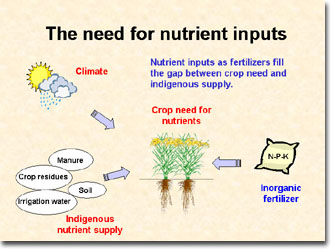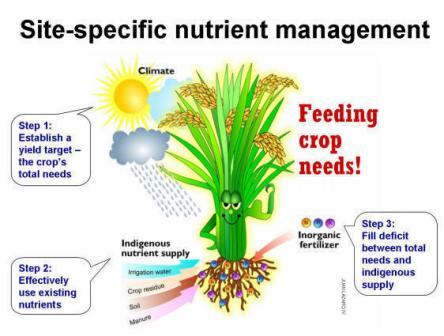|
|
|
Nutrient management |
|
|
|
|
|
|
|
|
|
Nutrients for irrigated rice: SSNM |
|
|
|
|
|
|
|
|
|
Describe the concept and usage of SSNM |
|
Remember: N=Nitrogen P=Phosphorus K=Potassium |
|
1. What is SSNM?
Site-specific nutrient management (SSNM) is a plant-based approach that provides principles that can be used everywhere. SSNM also gives guidelines for effective N, P, and K management so that rice farmers give their crop the right amount of essential nutrients.
With SSNM, plant-essential nutrients are supplied as and when required to ensure the ‘feeding’ of the rice crop to optimally meet its nutrient needs. SSNM enables the tailoring of nutrient management to field- and location-specific conditions.
|
|
|
|
|
2. Why use SSNM?
Soil does not usually supply enough nutrients to produce high, profitable yields — farmers therefore need to add fertilizers.
The growth and needs of a rice crop for supplemental nutrients can vary greatly among fields, seasons, and years as a result of differences in crop-growing conditions, crop and soil management, and climate. Hence, the management of nutrients for rice requires an approach that enables adjustments in applying N, P, and K to accommodate the field-specific needs of the rice crop for supplemental nutrients.
SSNM provides guidelines, tools and strategies that allow farmers to determine when and how much nutrients they need to apply to their rice fields under actual growing conditions in a specific season and location.
3. How to use SSNM?
|
|
|
|
|
||
Click on the link to read more about the LCC.
|
|
Step 1: Establish an attainable yield targetRice yields are location and season specific — depending upon climate, rice cultivar, and crop management. The yield target for a given location and season is the estimated grain yield attainable with farmers’ crop management when N, P, and K constraints are overcome. The amount of nutrients taken up by a rice crop is directly related to yield. The yield target therefore indicates the total amount of nutrients that must be taken up by the crop. Step 2: Effectively use existing nutrientsThe SSNM approach promotes the optimal use of existing (indigenous) nutrients coming from the soil, organic amendments, crop residue, manure, and irrigation water. The uptake of a nutrient from indigenous sources can be estimated from the nutrient-limited yield, which is the grain yield for a crop not fertilized with the nutrient of interest but fertilized with other nutrients to ensure they do not limit yield. Step 3: Apply fertilizer to fill the deficit between crop needs and indigenous supplyFertilizer N, P, and K are applied to supplement the nutrients from indigenous sources and achieve the yield target. The quantity of required fertilizer is determined by the deficit between the crop’s total needs for nutrients — as determined by the yield target — and the supply of these nutrients from indigenous sources — as determined by the nutrient-limited yield. The required fertilizer N is distributed in several applications during the crop growing season to best feed the crop’s need for supplemental N. Fertilizer P and K are applied in sufficient amounts to overcome deficiencies and maintain soil fertility.
In the SSNM approach, fertilizers are applied using the following principles to achieve high yield and high efficiency of plant use:
SSNM can be adjusted to local needs. Ensure farmer participation when you evaluate yield and profit in farmers’ fields. |
|
|
|
|
Recommendations for fertilizer application:
Click here for Nitrogen (K)
Click here for Phosphorous (P)
Click here for Potassium (K)
|
|
|
|
|
|
|
More information |
|
For more information about SSNM: Consult the SSNM web site at www.irri.org/irrc/ssnm. |
|
Next lesson |
|
In the next lesson we will discuss nutrient management for the rainfed rice ecosystem. |
|



